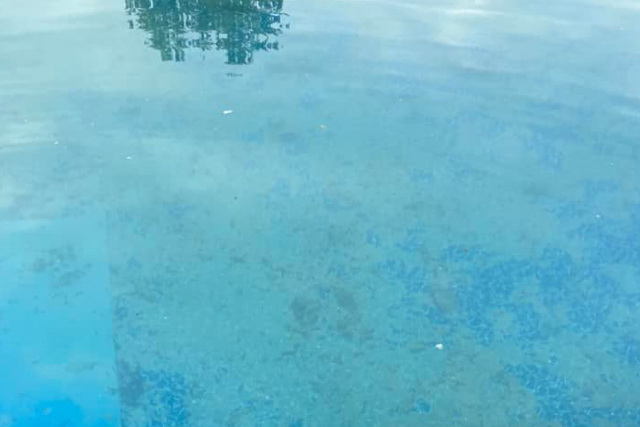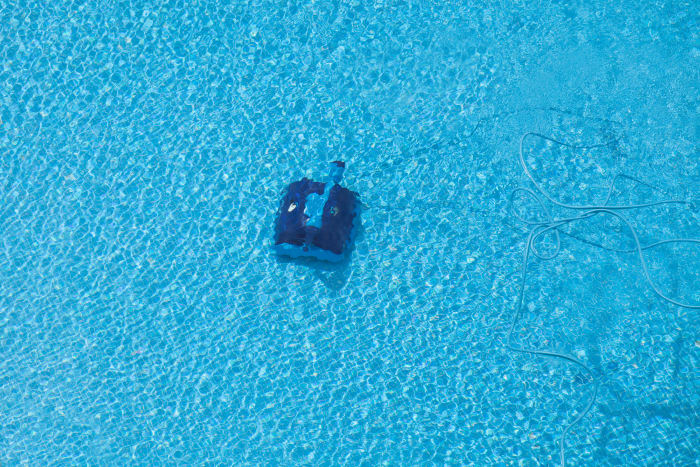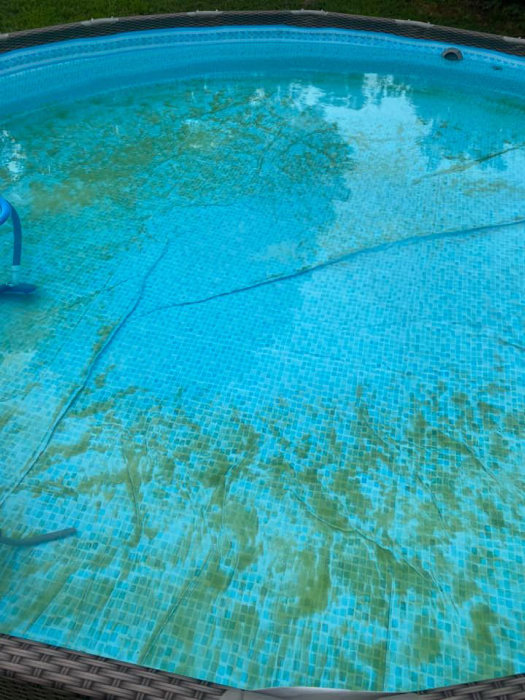Cleaning a green pool is a massive pain. Usually, you would shock your pool and then vacuum up the excess algae. But what if you have an above-ground pool or small pool and don’t have a pool vacuum? Or you don’t have a pool pump? Is it possible to remove algae without a vacuum?

Let me show you how.
Article Contents
13 Ways to Remove Algae from a Pool Without a Vacuum
You’re probably here because you either don’t have a pool filter and pump or just haven’t bought a pool vacuum yet. In this article I’m going to give you some methods to first kill the algae, which is likely why your pool is green, then I’m going to give you some ways you can get the dead algae out of your pool without a pool vac or pump.
1. Balance the Chemicals
You should always test the pool water first before applying chemical treatments. Pool algae can thrive in water with a high pH, as chlorine isn’t as effective. That’s why it’s so important to maintain a pH level between 7.2 and 7.6. Use a pool testing kit (I recommend a liquid drop kit but test strips will also work) to check the levels and adjust accordingly.
Additionally, maintaining the correct cyanuric acid level (CYA or stabilizer) is crucial to prevent algae. It should be 30 to 60 ppm. Higher than this, and the chlorine isn’t as effective. Lower levels mean the sunlight will destroy the chlorine, and there won’t be enough in the water to kill the algae.
Doing this first will ensure everything else you do will be more likely to work.
2. Brush and Scrub Algae Off Pool Surfaces
Manual brushing and scrubbing are essential steps in removing algae from pool surfaces. I like to use a pool brush with sturdy bristles. A steel bristle brush is good for concrete pools, and a nylon bristle brush should be used on fiberglass or vinyl liner above-ground pools. You want to scrub the algae off the walls, bottom, and any other affected areas. Pay extra attention to corners, crevices, and any hidden spots where algae tend to thrive.
Do this BEFORE shocking the pool.
Brushing alone can help loosen and dislodge the algae, making it easier for the shock and other chemicals to kill the algae.
- Perfect for vinyl or fiberglass pools.
- 17.5" extra wide head for fast cleaning
- Nylon bristles for gentle yet effective removal of algae & other scum
3. Manually Scoop and Skim
Manual scooping and skimming involves using a pool net or skimmer to remove the algae and debris from the pool water. This method requires much effort and frequent cleaning to prevent further algae growth. It is effective for smaller swimming pools or areas with localized algae problems. Choose a fine net so you capture as much algae as possible.
It’s also important to note that a lot of the algae floating in the water will be too small to get caught in the net. Keep reading for a look at how to deal with this.
4. Shock the Pool
The next thing that can be done without a pool vac is to shock the pool water. Pool shock refers to adding a high chlorine concentration to the pool to kill algae and other microorganisms. Follow the manufacturer’s instructions and dosage recommendations when using a pool shock product.
Remember, shocking the pool will kill the algae but not remove it.
If you have a pump and filter, run it for at least 24 hours to filter out the algae and distribute the shock throughout the pool water. If you don’t have a pump and filter, you’ll need to stir the shock in with a pool brush, pool net, or similar. We’ll look at ways to remove the dead algae later.
Repeat this process if your pool is still green the next day or the chlorine level is low (test the water again). It’s also OK to use a double or triple dose of pool shock if the algae is bad. But start with one dose.
- Powerful chlorine (68% calcium hypochlorite)
- Use as a shock or as regular chlorine for pools & spas to clear cloudy water
- Kills algae, bacteria and removes contaminants
5. Add Algaecide
In addition to adjusting the pH level and using a shock treatment, adding algaecide after your shock can help in getting algae out of your pool. Algaecide is specifically designed to target and kill algae. I would recommend Polyquat 60L algaecide or similar strength.
6. Add Clarifiers or Pool Flocculant
While algaecide and shock will kill the algae, clarifiers and flocculants help to improve water clarity and remove dead, suspended algae particles.
Add these and wait about 24 hours. Then, you can filter the water (if you have one, and clean the bottom of the pool).
7. Add Enzymes
Enzymes for the pool are specialized substances designed to break down organic matter and contaminants, ultimately improving water quality. They work by breaking down oils, lotions, and other substances that can accumulate. While enzymes effectively remove organic debris, they do not directly kill algae.
However, by breaking down the organic matter that algae feed on, they can indirectly help control algae growth by increasing chlorine efficiency.
8. Baking Soda and Borax (Optional)
Some people online mention that you can use baking soda and borax to kill algae in your pool naturally.
I don’t recommend this.
The only way to kill all the algae in the water is with a high chlorine/pool shock dose. And possibly an algaecide. These two things are what will kill algae.
In pools, baking soda is used to control the pH and alkalinity. However, it is important to note that baking soda is not an algae remover; it does not directly eliminate algae from the pool.
On the other hand, adding borates to the water (Borax) can actually be an effective solution for helping to inhibit algae in pools. This will not kill algae and is not a substitute for chlorine or algacide. It works by hindering the growth of algae and stabilizing the pH level.
Borax can be added to the pool water in small doses until the desired result is achieved. You want to have 30-50 ppm of borates in the water.
- Single dip and read test strip procedure
- Optimized color chart
- 50 test strips
9. UV-C Sterilization for Algae Elimination
UV-C sterilization is an effective method for algae elimination. UV-C light disrupts and destroys the DNA of algae cells, preventing them from reproducing. If you have a pool pump and filter, you can install a UV-C sterilizer in your pool’s circulation system to treat the pool water continuously and prevent algae growth.
Removing Dead Algae without a Pool Vacuum
When algae is dead, it usually sinks to the bottom of the pool and is grey. Some people call this “algae dust”. Let’s look at some ways for removing the dead algae dust from the bottom of your pool without a vac.
While you may be able to scoop some of the algae out from the bottom of the pool, a lot of it will be too fine. Here are some other ideas to remove the dust.
10. DIY Pool Vacuum
Here’s a game-changing solution for you: a DIY pool vacuum! And you don’t need a pool pump. Before you roll your eyes thinking this is some complicated project, let me assure you it’s not.
You’ll need a pool hose, pool pole, and a manual vacuum head. All you need to do is connect one end of the hose to the vacuum head. Take the other end of the hose and put it somewhere below the pool’s level. After you’ve done this, use a garden hose to fill the hose with water, and that will create a siphon.
Voila! You’ve just created your very own pool vacuum.
Simply move the contraption along the bottom of your pool, and watch it suck up all that dead algae from the bottom of your pool. It may not be the fanciest vacuum in town, but it does the job without breaking the bank.
11. Water Powered Pool Vacuum
Unlike traditional pool vacuums that require a pool pump and filter, electricity, or batteries to operate, a water-powered vacuum uses the pressure from your garden hose to create suction and remove dirt, leaves, and other unwanted particles from the pool floor and walls. This type of vacuum is easy to use and does not rely on any additional power sources, making it very cheap to buy and an environmentally friendly choice.
These are ideal for cleaning dead algae dust from small pools or medium above-ground pools without using a pool pump.
- No electric power needed
- Collects stones, leaves, dirt, sand & sticks
- Attaches to a standard garden hose
12. Robot Pool Cleaner

If you’re looking for a solution to remove algae without needing a filter and pump, a aboveground robot pool cleaner may be what you’re looking for. It is equipped with advanced technology and sensors to efficiently navigate the pool and clean the entire surface. Robotic pool cleaners have a built-in filtration system that helps remove algae, debris, dirt, and leaves from the pool. This means you don’t need a pool pump or external filter to use it.
Some models also have scrubbing brushes to scrub algae on the walls and floor. These cleaners use a combination of water pressure and suction to ensure thorough cleaning.
While effective and save time and effort, they are quite expensive.
13. Battery Powered Pool Vacuum
A battery-powered pool vacuum is a cheaper alternative pool vacuum if you don’t have a pump. Perfect for getting algae out of Intex pools, Bestway pools, kiddie pools, and small above-ground pools.
They operate using rechargeable batteries, making them portable and convenient to use. This type of pool vacuum is generally more affordable than other options, such as robotic or automatic pool cleaner vacuums.
The cost of a battery-powered pool vacuum can vary depending on the brand, size, and features it offers. Generally, they are $100 to $400.
Overall, I would highly recommend this type of pool cleaner for anyone with a small portable pool or even a larger above ground.
What Contributes to Algae Growth in Pools
One main factor contributing to algae growth in pools is sunlight. Algae require sunlight for photosynthesis, and exposure to direct sunlight can make it easier for algae to thrive in your pool. Additionally, warm temperatures create an ideal environment for algae to grow rapidly.
Low chlorine levels or ineffective sanitization can also lead to pool algae growth. Chlorine is a powerful disinfectant that helps keep the pool water clean. When the chlorine levels are insufficient, it becomes easier for algae to multiply and form blooms in the pool water.
Poor pool maintenance practices can also contribute to algae formation. Neglecting to regularly clean and maintain your pool provides the perfect conditions for algae to flourish. Lack of proper filtration, inadequate water circulation, and debris in the pool can all promote algae growth.
Common Types of Algae in Pools

Algae that can be commonly found in pools include:
Green algae is the most common type and appears as a greenish discoloration on the pool surfaces. Black algae is more stubborn and difficult to remove, often appearing as dark spots with a firm texture. Mustard algae is yellowish and usually forms in shady pool areas.
Shock treatments work best on green and mustard algae types. Not so much black algae.
Recognizing Signs of Algae Presence in Pool Water
It is important to recognize the signs of algae in your pool water to take prompt action and prevent further contamination. Several visible indications can alert you to the presence of algae:
1. Visible Indications of Algae Growth
One of the most obvious signs of algae growth is the appearance of greenish or cloudy water in your pool. If the water has a green tint and does not look clear, algae will likely start forming. You may also notice slimy or slippery pool surfaces, especially near the walls and bottom of the pool.
2. High Chlorine Demand
You may have noticed that your pool requires much more chlorine than normal. This is a sign that you have algae. Even if you can’t see it.
3. Slimy Surfaces
Steps or walls of your pool that feel slippery or slimy likely mean you have algae coming. Grab a brush, scrub it away, then shock the pool water to ensure algae doesn’t take hold.
Tips to Prevent Algae
Prevention is always better than cure for algae in your pool. By following these key maintenance practices, you can significantly reduce the chances of algae infestation:
- Regular testing and balancing of pool water chemistry
- Proper pool filter cleaning and maintenance
- Effective pool skimming and debris removal
- Maintaining adequate water circulation





